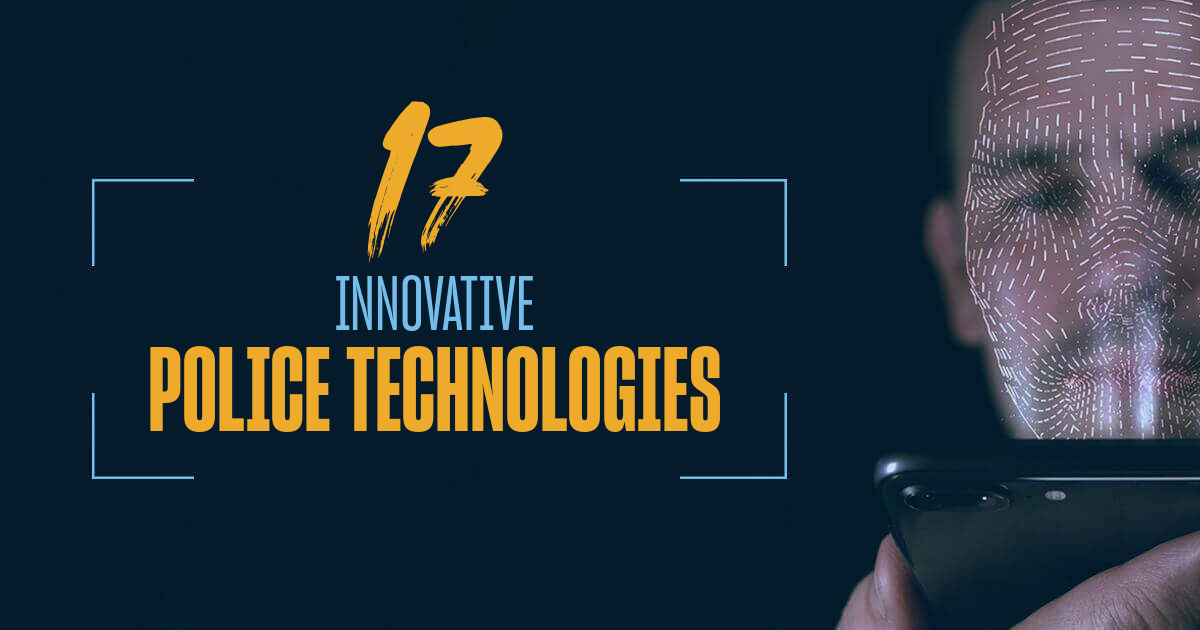Technology is transforming police work in the 21st century — introducing new tools to fight crime and new categories of crime to fight. For example, while more and more police departments across the country are deploying drones as eyes in the sky, the FBI reports they are also being used for criminal activities.
When this post was first written in 2016, these technologies were just rolling out across agencies. Now, with the rapid pace of technological developments, agencies are finding new and innovative ways to leverage these tools to enhance public safety, catch criminals and save lives.
Eyes on Innovation – Police Technology
Digital Forensic Software
This type of software is used to find, recover and preserve digital evidence that’s often associated with electronic crimes, such as credit card fraud or child pornography. But many non-electronic crimes also include digital evidence, such as bank account information, phone numbers, emails, text messages and social media posts.
Digital forensic software has special capabilities, such as identifying and recovering hidden (or deleted files), performing complicated searches and determining the contents of a file beyond the file extension (.doc, .pdf, etc.).
Information Sharing Technology
Communication among law enforcement agencies has always been a challenge, but certain types of technology are helping to bridge the gap so that everyone is on the same page. One of the goals of the Department of Homeland Security Science and Technology Directorate is to “fund projects that help state and local response agencies share timely information about emergencies with each other and the public.” A few of these include the Next-Generation Incident Command System and Wireless Emergency Alerts.
Another example: OpenFox® information sharing products and programs. In particular, the Message Switch System “provides access to a wide variety of city, county, state and federal criminal justice agency information and allows criminal justice integration efforts between probation and parole officers, the U.S. Department of Homeland Security and other law enforcement entities around the world.”
Virtual Reality Training
Virtual reality (VR) training for law enforcement provides a safe, immersive experience that simulates real-life behavior and scenarios as much as possible. It also demonstrates to potential officers that a department or agency is serious about the latest innovations and educational tools, which can help with recruiting.
VR training is now being used for new recruits in the Pulaski County Sheriff’s Office in Arkansas. The flexibility of the system allows officers to vary scenarios and settings to include shopping malls, neighborhoods and schools. At the Tequesta Police Department in Florida, officers use VR tools to practice responding to hostage and active shooter situations and help individuals in mental distress.
eCitations and Mobile Printers
Advances in technology now make it possible for law enforcement officers to issue citations without spending precious minutes filling out paperwork by hand. Here’s how the process works: The officer uses a device to scan the barcode on the driver’s license. The information populates a citation, which the officer prints using a mobile printer. The officer can also send the citation to the courthouse digitally, all of which saves time, increases efficiency and reduces errors.
In one successful example, the police department in Olathe, Kansas switched to this technology, decreasing the time it takes to issue a citation from 15–20 minutes to 2–3 minutes.
Facial Recognition Software
One of the more controversial emerging police technologies involves the use of facial recognition software. When this tool first made its way into law enforcement repertoires, many were concerned that it would be used unethically. Thankfully, that has not been the case, and facial recognition is proving to be an effective investigative tool.
The goal of facial recognition software is that it will help improve safety and security in a number of instances. NYPD officers were able to find and arrest a rape suspect within 24 hours of the attack using facial recognition software. And, because facial recognition is so promising, the U.S. Department of Homeland Security predicts that it will be used on 97 percent of travelers by 2023.
[RELATED] The Ultimate List of Top Police Blogs & Websites >>
Biometrics
Police have been using fingerprints to identify people for more than a century. Now, in addition to facial recognition and DNA, there is an ever-expanding array of biometric (and behavioral) characteristics being utilized by law enforcement and the intelligence community. These include voice recognition, palmprints, wrist veins, iris recognition, gait analysis and even heartbeats.
The FBI has developed a database called the Next Generation Identification (NGI) system, “which provides the criminal justice community with the world’s largest and most efficient electronic repository of biometric and criminal history information.”
With comprehensive electronic databases now in place to more effectively use DNA and other biometric data in law enforcement, even the use of fingerprints to identify suspects has gone high-tech. For example, a CNBC report explains how police in London can now use a mobile INK (Identity Not Known) biometrics device to scan a suspect’s fingerprints and in many cases reveal their identity within 60 seconds.
Voice Technology
An officer’s patrol car is like a mobile command center, meaning there are numerous computers and tools that an officer can use while on the road. But because there are so many different features, safely multitasking can be difficult. One of the latest innovations being incorporated into police cars is a new voice command technology that empowers officers to control many functions in their vehicle while driving and performing other patrol duties.
The capabilities of these voice systems vary from vehicle to vehicle, but most can handle commands to run a license plate or turn on a siren. The more advanced and most promising capability of voice command technology in police cars will make filing reports much easier — officers can dictate their notes which are then logged directly into their agency’s RMS system.
Robots
Many law enforcement agencies are now using next-generation robotic cameras to deliver visual and audio surveillance of potential crime scenes that may be too dangerous or too hard for officers to reach.
Some of these devices are even “throwable” (up to 120 feet and capable of withstanding repeated 30-foot drops) — powered by an electric motor and equipped with high-tech wheels that enable them to move, climb and explore even the most challenging spaces while being operated wirelessly by a trained officer.
Automaker Ford has filed a patent for a self-driving police car equipped with artificial intelligence. These high-tech cruisers are designed to catch violators of traffic laws or impaired drivers by transmitting information to human officers or carrying an optional passenger officer who could make arrests.
Additional applications for using robots in police work, now and on the near horizon, include:
- Ever-expanding capabilities for robots to gather surveillance information, take police reports and provide communications in settings where human officers’ safety would be compromised
- China’s ongoing development of an “AnBot” robot to patrol banks, airports and schools
- Patrolling tourist attractions with a touchscreen-equipped robot officer, as is now on duty in Dubai
Video Doorbells
Video doorbells have been installed by thousands of homeowners as a way to enhance home security and give them peace of mind. It turns out, though, that these surveillance systems are also helping law enforcement when it comes to criminal investigations. In 2020 alone, law enforcement agencies across the U.S. made more than 20,000 requests last year for footage captured by Ring video doorbells and other home-security cameras. Amazon — which owns Ring — has entered into more than 2,000 cooperative agreements with law enforcement agencies, which allows them to automatically ask camera owners for their security footage if they live near a crime scene.
ShotSpotter
“Shots fired!” is not an uncommon dispatch from witnesses or officers on patrol, but pinpointing the exact location of the gunfire takes up precious time when every moment counts. Today, more and more cities are implementing ShotSpotter technology that uses sensors to detect gunfire and analysts to track the data and instantly relay it to police, enabling them to arrive on the scene more quickly than ever before.
Named for the leading provider of this technology — California-based ShotSpotter — the service can cost $40,000 to $60,000 per square mile per year for cities to cover high-crime areas. The company claims it can “detect 90%+ of gunfire incidents with a precise location in less than 60 seconds to significantly improve response times.”
A dramatic example of ShotSpotter in action took place in 2017 in Fresno, Calif., where police used it to apprehend a criminal on a killing spree. The technology enabled police to trace the killer’s movements and apprehend him in 4 minutes and 13 seconds.
[RELATED] What Law Enforcement Leaders Should Know About Intelligence-Led Policing (ILP) >>
Thermal Imaging
Thermal imaging has become an important police technology tool that is especially helpful in dark conditions. Thermal image cameras, some available as small hand-held units, utilize infrared imaging to detect heat emitted by such objects as humans and animals, and to deliver a “heat picture” or “heat map” of the environment in question.
As seen on any number of TV crime shows, it can be used to track the motion of suspects in a darkened building. Such technology has life-saving applications — from firefighting to search and rescue missions (for example, finding a lost child or senior citizen in a blinding snowstorm).
Artificial Intelligence
The ongoing expansion of the Internet of Things (IoT) means more data is being generated, collected and analyzed than ever before — much of which can be incredibly valuable in a law enforcement context.
But the process of deriving actionable insights from immense amounts of data is so incredibly time-consuming that it is not remotely cost-effective when performed by humans. That’s where artificial intelligence (AI) and its subcategory machine learning come in. AI is used to support many other police technologies, including some of those mentioned above like ShotSpotter, facial recognition and biometrics. It can also be used for crime mapping: crunching data that can be used to far more effectively pinpoint high-crime areas, so police can monitor them more closely and deploy additional resources.
Artificial intelligence is also being used for “crime forecasting.” Utilizing so-called “deep learning” algorithms, programmers can train computers to analyze data from a vast array of sources and categories to actually predict when and where crimes are likely to occur. This allows agencies to properly allocate resources and increases the likelihood that officers will be in the right place at the right time.
Smarter Cruisers
Police cruisers have come a long way since the first police car hit the streets of Akron, Ohio, in 1899 (with a gong for a siren and a cell in the back for prisoners).
Innovation in modern police cruisers (and those of the future) has brought about such upgrades as fingertip access to Wi-Fi connected laptops, tablets, and in-dash computers, giving officers the benefit of instant access to vital information, communication systems, and more.
Enhanced dashcam capabilities are highly useful for surveillance and information gathering, as well as for evidentiary and accountability purposes. Next-generation officer safety features (for example, armor-piercing bulletproof doors) are also being incorporated into some police vehicles, and semi-autonomous operational capabilities are not far down the road.
Automatic License Plate Recognition (ALPR)
The same technology that enables toll collectors to automatically scan and collect the registration numbers and letters on your license plate to charge you a fee is now being used by police for a variety of law enforcement purposes, from identifying stolen cars to catching up with people who have active warrants or monitoring “Amber Alerts.” However, the technology law enforcement uses for ALPR has taken another innovative step forward.
The latest in ALPR technology combines optical recognition technology with AI, allowing law enforcement to reliably and consistently identify license plates. Before the enhanced AI capability, some ALPR cameras provided low-resolution and blurry images, making proper identification difficult. With AI, ALPR cameras can identify “the make, model and color of cars even in low light and poor weather, distinguish individual characters on license plates, learn new plates as they appear and expand its database to include updated and unfamiliar designs.”
The reality that multiple cameras could be capturing images of the same license plate potentially gives police the ability to track a vehicle’s movements over time, revealing details about an operator’s whereabouts, which could obviously be helpful in catching criminals.
However, privacy advocates like the ACLU — asserting that drivers are not voluntarily offering up detailed information on their comings and goings — warn that such powerful technology should be subject to restrictions and close monitoring to ensure it is not being abused. Many states and law enforcement agencies have put in place limitations to how this valuable technology is deployed.
Enhanced Body-Worn Cameras
Video of police officers doing their jobs in challenging situations used to be rare; today it is ubiquitous, as seen in a number of high-profile incidents that have drawn intense public and media scrutiny.
As more cities and communities choose to equip police departments with body-worn cameras, the ability of law enforcement supervisors, as well as the public, to gain a street-level view of on-duty police work has expanded dramatically — setting in motion an ongoing debate around the importance and the impact of this technology.
In addition to being smaller, less cumbersome, and more durable, some body-worn cameras are designed to better integrate with in-car systems to provide synchronized video of an event from multiple points of view. Other advancements include higher resolution, clearer audio, wider fields of vision, and heightened resistance to environmental conditions such as extreme cold.
Related technology now includes smart holsters that are designed to activate the body camera anytime the officer draws his or her firearm. At least one manufacturer of body-worn police technology makes a camera capable of issuing an alert when an officer is down. On the horizon: body-worn police cameras equipped with facial recognition capabilities.
Drones
Also called unmanned aerial vehicles (UAVs), drones are increasingly being used by police to gain aerial vantage points for crime scene work, search and rescue efforts, accident reconstruction, crowd monitoring and more. Some of the more sophisticated models can be equipped with thermal imaging or 3D mapping software to offer GPS-enhanced precision to the areas being surveyed.
Many police drones and UAVs are also equipped with zoom cameras, making them incredibly valuable for delivering actionable, real-time intel in high-risk, “armed and dangerous” situations.
Mastering the Use and Implications of Police Technology
As police technology continues to evolve, law enforcement leaders have a powerful stake in staying well-informed about these advanced capabilities — both their positive impact on the safety of officers and the public, and the ethical questions involving rights to privacy.
Police chiefs and agency executives will need to understand the pros and cons to make informed recommendations on what technologies their departments and communities should be investing in. Retired California police chief Jim Davis explains that, when he started his career, “if we were 10 to 20 years behind in technology it really didn’t matter that much. But now, if you are 10 to 20 days behind in your technology the bad guys are getting way ahead of you.”
Chief Davis, a faculty member of the online Master’s in Law Enforcement and Public Safety Leadership program offered by University of San Diego, emphasizes the importance of lifelong learning for any law enforcement leader wishing to stay abreast of the accelerated pace of police technology development. “It is clear that our profession has become much more complicated. Now more than ever, continuing education is a critical component of your ability to lead your organization and serve your communities.”
Police Technology Jobs
Technology jobs are booming in practically every industry, and law enforcement is no exception.
Technology jobs in policing include drone pilots, electronic surveillance officers, digital forensic investigators, real-time crime analysts, social media researchers and accident reconstructionists — among many others.
In fact, a search for technology jobs in law enforcement on LinkedIn and Indeed revealed hundreds of results with titles such as:
- Data analyst
- Computer forensic instructor
- Intelligence analyst
- Research analyst
- Police business systems analyst
- Computer scientist
- Laboratory technician
- Law enforcement technology project manager
- Police systems administrator
- Law enforcement data science program manager
- Law enforcement content developer
- Senior cybersecurity incident investigator
- Cybercrime analyst/investigator
These types of positions are available not only at sheriff’s departments, police departments and government agencies such as the Federal Bureau of Investigation, but also cities, states and companies like Lexipol that create training solutions for law enforcement.





